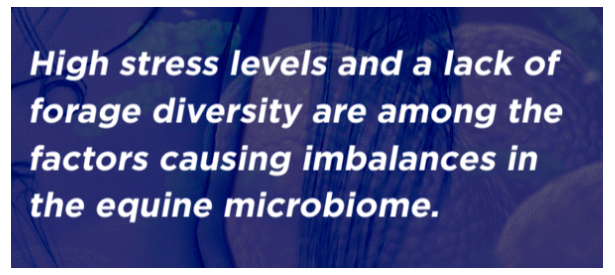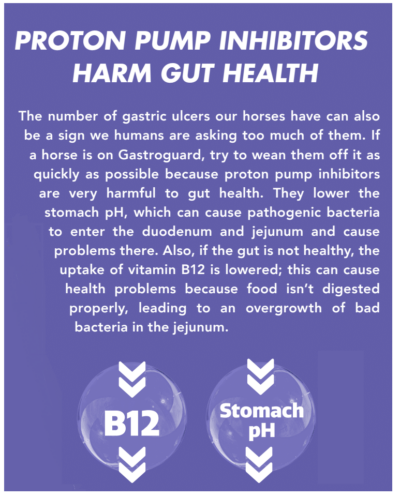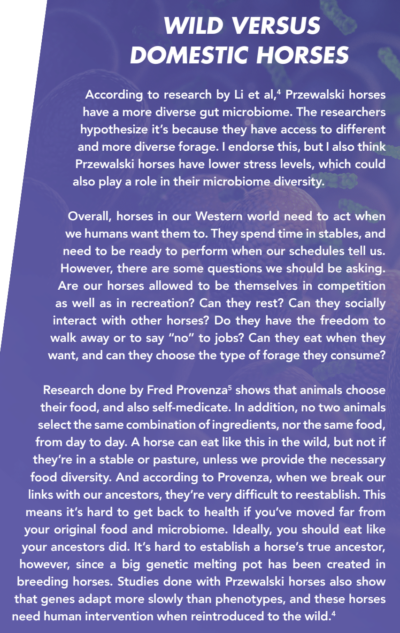No feet, no horse. This old saying says it all, and can be extended to gut health as well. In fact, I would dare say: No gut, no horse. If a horse doesnt have optimal gut microbiome health, they wont have optimal overall health. The equine world is increasingly recognizing this truth, but we still have a long way to go, and the way we care for our horses in general can interfere with achieving good gut microbiome health. Its vital to have an understanding of the equine microbiome, along with what causes it to get out of balance and how you can support it to reestablish well-being.
HORSES ARE HINDGUT FERMENTERS
The horse is capable of utilizing a wide range of plant species1 as a hindgut fermenter. This fermentation is done by a complex microbial system in the gut. The bacteria, viruses, archaea, and fungi that make up the microbiome thrive on high fiber, low energy forage.2 The microbiome helps transform non-digestible fiber into short chain fatty acids to be used by the immune system to lower inflammation; as an energy source for the intestinal cells; and to repair the gut lining.

MICROBIOME DIVERSITY IS CRUCIAL
When the diversity of organisms in the microbiome decreases, chronic illnesses appear. A variety of factors can change the microbiome, and these alterations are very complex to understand. All the research that has been done involves equine feces, and its unclear if they completely represent the microbiome in the hindgut. In addition, the scope of human microbiome research is shifted to the metabolome the study of metabolites, which could include lipids, amino acids, short peptides, sugars, alcohols or organic acids. This means, for example, not examining the bacteria in the gut, but what they are transforming and how it will benefit or harm the host.
What the research makes clear is that the equine microbiome is dramatically changed if the horse has diseases such as laminitis or severe colic. But there is another way to look at it. I think the lack of diversity in the equine microbiome, whatever the reason behind it, is causing chronic illnesses like metabolic diseases, PPID, and others to develop.
horse has diseases such as laminitis or severe colic. But there is another way to look at it. I think the lack of diversity in the equine microbiome, whatever the reason behind it, is causing chronic illnesses like metabolic diseases, PPID, and others to develop.
A horse is meant to walk several miles a day and search for diverse foods, including different grasses and herbs and the tough little branches on trees. This diversity in forage leads to diversity in the gut microbiome. The more diverse the gut bacteria, the less disease will occur. In humans, we can see how unhealthy lifestyles are impacting overall health. With less diversity in our microbiomes, more diseases are arising.3
THE GUT-BRAIN AXIS AND STRESS
More and more human studies are being done on the gut-brain axis, showing that the vagus nerve plays an important role. The gut interacts with the brain cells, and vice versa. Chronic stress undermines the gut microbiome. The HP axis is continually activated and the sympathetic nervous system is in overdrive, resulting in increased cortisol levels. This results in immunodeficiency and chronic intestinal illnesses.
Studies in mice and human athletes have shown that endurance tests and involuntary exercise harm the gut microbiome, while voluntary exercise benefits it.7,8 A study done in horses, meanwhile, showed that demanding endurance tests caused increased intestinal permeability; raised pro-inflammatory interleukines; and produced LPS (lipopolysaccharide), an endotoxin that can enter the bloodstream and cause more harm to the immune system and microbiome.9
HOW TO SUPPORT THE EQUINE MICROBIOME
1. Look at how the horse is managed, with the goal of reducing stress levels. If a horse doesnt want to work, try to figure out why not by listening more carefully to them. Dont look on the horse as a possession. Horse and human comprise a partnership, in which they  co-exist with one another. Look at the horses social interactions with both friends and bullies within the herd. Can the horse escape from a bully, and find comfort from companion horses? Is the work you do with the horse good for them? Is it too monotonous, too difficult, or too restraining? Is the horse non-compliant or submissive with bit, spurs and side reins? In summary, take a closer look at the horse and the behavior theyre showing.
co-exist with one another. Look at the horses social interactions with both friends and bullies within the herd. Can the horse escape from a bully, and find comfort from companion horses? Is the work you do with the horse good for them? Is it too monotonous, too difficult, or too restraining? Is the horse non-compliant or submissive with bit, spurs and side reins? In summary, take a closer look at the horse and the behavior theyre showing.
2. Try to get the horse in balance by enhancing the gut-brain axis and giving attention to the vagus nerve. This balance can be achieved by osteopathy and/or acupuncture. The communication between the brain and the gut will increase, cortisol levels will drop, and the horses health will reestablish.
3. Look at the horses forage. As far as Im concerned, few horses need concentrate feed. Good hay or grass and quality mineral sources are enough. In his 40 years of study, Provenza found that animals need good plant diversity to achieve optimal biochemical composition in the body and obtain good health. He stated that animals eat 50 to 75 different plant species in one meal. So dont feed horses a monoculture diet. The quality of the food is also important, so no hay or grass that has been sprayed with herbicides like glyphosate, or is full of heavy metals due to pollution.
4. Guard against obesity. A lot of horses are too fat. They eat too many sugars and dont get enough prebiotics, the insoluble starches. Obesity indicates an imbalance in the gut microbiome. Every craving you have is actually the microbes in your gut speaking to your brain (gut-brain axis); they want a certain type of food and are signaling to get it in order to grow and to stay alive.
In humans with obesity, the ratio between bacteroidetes and firmicutes has changed. The proportion of bacteroidetes is reduced11 bacteroidetes transform non-digestible carbohydrates such as pectine, oligosaccharide and insulin. This research has also been done in horses with the same results seen in the ratio between bacteroidetes and firmicutes.11 In humans, supplementing with Akkermansia muciphinilia shows improvement in obesity and metabolic disease.12
In the study done by Hu et all, firmicutes were found to be higher in captive Przewalski horses than in wild ones.6 Also, Provenzas research showed that if an animal lacks a certain mineral or vitamin, they will overeat to compensate for the deficiency. Its better to give whole foods instead of supplements to help with a deficiency. So keep this in mind if you want to lower a horses weight.
5. Make sure the horse eats slowly and without stress. If a horse eats slowly enough, saliva is produced and the digestion process starts. Eating slowly also ensures the food is broken down into very small particles, which increases digestion in the stomach. Stress causes digestion to decrease so the peptides cant be properly broken down into amino acids. This can cause SIBO (small intestinal bacteria overgrowth) because the proteins can be used by the bad bacteria in the jejunum, causing the overgrowth. Also, the food bolus stays in the stomach longer and causes problems in the duodenum.
6. Ensure the horse drinks enough water. This helps the digestive system and detoxes the body. Its important the horse has access to fresh, ample drinking water.
7. Think about the medications you use and how they Might affect the gut microbiome. Try to deworm with natural products and good pasture management. If thats not doable, try to deworm as little as possible after an egg count.
If a horses stress level is reduced, and their forage optimized, yet there is still need for intervention, decreasing inflammation, helping the body detox, and eliminating pathogens will also help build a good gut microbiome.








